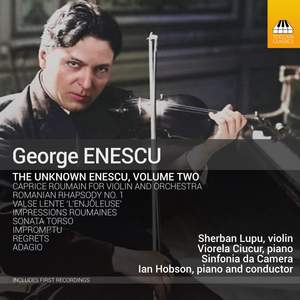
George Enescu (1881-1955)
The Unknown Enescu – Volume Two
Romanian Rhapsody No 1 in A major, Op 11, No 1 (1901; arr. Marcel Stern, publ. 1957)
Impressions Roumaines for solo violin (1925; arr. Lupu, 2008)
Sonata Torso (1911)
Impromptu concertant in G-flat major (1903)
Regrets (1898; compl. Lupu, 2018)
Suite No 1 in G minor, Dans le style ancien, Op 3: Adagio (1897; arr. Sandu Albu, 1929)
Valse lente ‘L’enjoleuse’ (1902)
Caprice Roumain (1925–49; compl. Cornel Ţăranu, 1994–96)
Sherban Lupu (violin)
Viorela Ciucur (piano)
Sinfonia da Camera/Ian Hobson (piano)
rec. 2001-2022
TOCCATA CLASSICS TOCC0647 [72]
The first volume in this series was devoted to Enescu’s music for violin in various permutations. This second volume again features Sherban Lupu, something of a heroic figure for his multi-volume recordings of the music of Ernst, and so too in his discs of his fellow countryman, Enescu. This latest CD sees Lupu disinter torsos and almost complete works in performing editions that bring to light a swathe of ‘new’ Enescu.
The Romanian Rhapsody was one of Enescu’s most brilliant early works and has been multiply arranged over the years. This version for violin and piano (Lupu and Ian Hobson) was arranged by violinist and composer Marcel Stern and published in 1957. It’s a scintillating and stylistically apt refashioning of the orchestral original, preserving much of the music’s colour and glistening folkloric bravura. Impressions Roumaines for solo violin was composed in 1925 and was discovered by Lupu in the Enescu Museum in Bucharest. 30 bars survive and Lupu’s arrangement exemplifies, indeed amplifies Enescu’s desire to bring native folk music to the concert stage in a way that doesn’t diminish its pungency of expression or downplay its harmonic variety. A larger work is the 15-minute Sonata Torso of 1911 completed between the second and third violin sonatas. It’s the first part of a sonata that Enescu abandoned and more romantically-inclined than the later Third Sonata, its ripe lyricism growing progressively more melancholic and funereal. The troublingly intense sense of tragedy is intensified by the coda. Enescu’s mother had died in 1909 and it’s not fanciful to read into this abandoned sonata movement of 1911 autobiographical elements. As to why he abandoned it, maybe the focused, tragic nature of the completed movement couldn’t be followed by a Scherzo, which might sound unseemly.
Enescu wrote a sequence of smaller pieces that exude Parisian light-heartedness, such as the Impromptu concertant of 1903, a songful salon effusion, and Regrets, completed by Lupu. There’s also an Old School Adagio from the Suite No 1 of 1897, heard here in the arrangement, made in 1929, of Sandu Albu. It’s a chorale-like piece composed when Enescu was 16. A few years later he wrote a waltz called L’enjoleuse employing the pseudonym ‘Camille Grozza’, and this reflects the scattered, disparate nature of these early works.
The largest-scaled piece here is the Caprice Roumain, written between 1925-49 and heard in the performing edition of Cornel Ţăranu, which was made between 1994–96. It was first performed in 1997, by Lupu, and this recording followed in 2001. There are four movements of what is, in effect, a reconstructed violin concerto in which Lupu is joined by the Sinfonia da Camera directed by Hobson. It is fuelled by characteristic folkloric elements, slow-fast, rich and ripe in the opening Ben moderato and by a gently insinuating Hora in the second movement. The vibrant coloration of the slow movement is made the more alluring by virtue of the ornaments and rich reservoir of folkloric melancholy of the music whereas the finale is crisp, brisk and attractive.
This is another valuable disc and far more than merely chippings from the composer’s bench. It traces the young composer back to 1897 and forward to those long-gestating sketches for the Caprice Roumain for which much deconstructing and reconstructing has been necessary given the stylistically divergent material, composed over many years, with which Cornel Ţăranu had to work. These recordings, too, were made over many years, the earliest in 2001 and the most recent in April 2022 when Lupu was joined by pianist Viorela Ciucur. He plays splendidly, as ever, statistically apt and only very occasionally challenged intonationally. Let’s hope there’s more from him and Toccata lined up.
Jonathan Woolf
Recording information
Help us financially by purchasing from



rec. March 2004, Krannert Art Museum, Champaign, Illinois, live (Romanian Rhapsody): February 2001, Foellinger Great Hall, Krannert Center for the Performing Arts, Urbana, Illinois (Caprice Roumain): April 2022, George Enescu Auditorium, University of Music, Bucharest (remainder)


















